This information will help you relearn how to move around, care for yourself, and do your daily activities safely after your surgery. It’s important to have all the equipment you need before you go home. Your healthcare team will meet with you and let you know what you need and where to get it. Learn more about
getting your home ready.
Using walking aids
You’ll learn how to walk properly with a walking aid during your recovery. Let your nurse or physical therapist know if you’re worried about falling while you’re relearning to walk and move around.
Use a walking aid at all times to protect your hip. Your healthcare team will let you know which walking aid is right for you. Use a walking aid until your healthcare team says you don’t need it anymore. Walking aids include:
Find out more about how to use a
2-wheeled walker,
4-wheeled walker,
cane, and
crutches.
Using the toilet
You may need a raised toilet seat and toilet armrests. If you’re using a raised toilet seat and toilet armrests, make sure the toilet paper is within easy reach before you sit down.
When you sit on the toilet:
- Back up until you feel the toilet touch the back of your legs.
- Move your leg that had the surgery slightly forward (so you're not bending your leg too much).
- Bend both knees and lower yourself slowly on to the toilet seat. Use the countertop, sink, or toilet armrests for support.
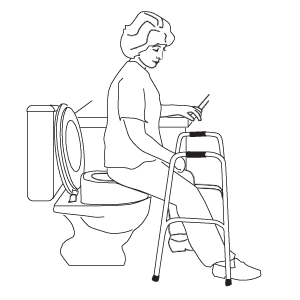
How to safely use a toilet
Credit: Bone & Joint Health Strategic Clinical Network, Alberta Health Services
When you’re done using the toilet, follow these steps in reverse (do steps 3, 2, then 1) to stand back up. Don’t use your walker to raise yourself from the toilet. Always push up with your hands to get up from where you’re seated.
Getting in and out of bed
You may find it hard to get into bed on the same side as you usually do. Avoid low beds, very high beds, and soft mattresses if you can.
When you’re lying on your side or back, support your leg that had surgery with a pillow between your legs. You may also find it more comfortable to use 1 or 2 pillows to keep your legs apart when lying in bed.
To get into bed:
- Back up until you feel the bed behind your knees. Move your leg that had surgery slightly forward.
- Hold onto the crutches with one hand. Reach behind with your other hand to find the top of the bed. If you’re using a walker, reach for the bed with both hands.
- Sit and slide your bum (buttocks) onto the bed.
- While sitting, shift your body as you lift your legs onto the bed. To help lift your leg onto the bed, you can support the leg that had surgery with your other leg or with a leg strap.
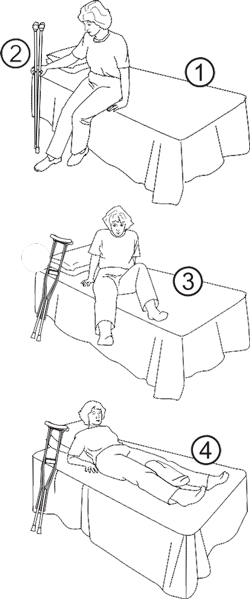
Getting safely into bed
Credit: Bone & Joint Health Strategic Clinical Network, Alberta Health Services
When you’re ready to get out of bed, follow these steps in reverse (do steps 4, 3, 2, and then 1).
Bathing
It’s important to make your shower and tub safe for you to use. Your occupational therapist may suggest you use some or all of this equipment:
- a bath or shower seat that you can move up or down
- a tub grab bar or other safety bars or rails
- a long-handled bath sponge
- a handheld shower head
To keep yourself safe when you bathe:
- Sit in a bath seat or chair to shower.
- If you’re unable to get into the shower or bathtub, sit by the sink to have a sponge bath.
- Have a wooden chair or sturdy stool in the bathroom so you can sit when drying yourself.
- Put a non-slip mat in the bathtub.
- Use a rubber-backed bathroom mat.
- Remove any scatter rugs from the bathroom.
Your occupational therapist may recommend that you don’t use a tub with sliding doors. If your tub has sliding doors, they may ask you to have someone take them out and put up a shower curtain instead.
Your occupational therapist will let you know what equipment and changes to your bathroom are best for you.
Getting into a walk-in shower
- Walk to the edge of the shower. Turn away from the shower stall.
- Hold onto the middle of the horizontal bar on your walker with 1 hand. Use the other hand to reach for the back of the chair in your shower.
- Move your leg that had surgery forward.
- Slowly sit down on the chair.
- Lift your legs over the edge of the shower stall, then turn to sit facing the faucet.

Credit: Bone & Joint Health Strategic Clinical Network, Alberta Health Services
Getting into a bathtub
- Stand in front of the tub. Turn, then back up slightly with your walking aid so that you can feel the tub against the back of your legs.
- Hold onto the tub rail for support. With your other hand, reach back for the bath seat.
- Move your leg that had surgery slightly forward. Slowly sit down on the bath seat.
- Turn so you’re facing the faucet. Lift your legs one at a time up over the side of the tub.
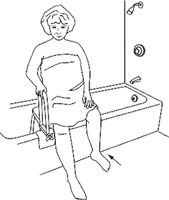

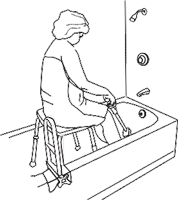
Getting safely into the bathtub
Credit: Bone & Joint Health Strategic Clinical Network, Alberta Health Services
To get out of the tub or shower, start at the last step and work your way back to step 1.
Getting dressed
Your occupational therapist will show you how to use a reacher or long-handled shoehorn to help you get dressed and protect your hip. Other tips for getting dressed safely include:
- Choose loose-fitting clothes.
- Wear socks with low-heeled shoes (like running shoes) for firm support.
- Dress the leg that had surgery first and undress it last.
Getting in and out of a car
Your therapist will tell you how to get in and out of your car safely based on the type of car you have or are travelling in. Sit in the front seat whenever you can. Try not to travel in small cars, use low bucket seats, or travel in vehicles that are high off the ground and hard to get into (like some trucks).
Before you get to the vehicle, have your driver park the car about 1 metre (3 feet) away from the curb. Slide the passenger seat back as far as it will go. You may find that having a large plastic bag on the seat makes getting in and out of the car easier.
To get into a car:
- Back up with your walking aid until you can feel the edge of the car against the back of your legs.
- Hold the back of the seat and the car frame for support. Slide your leg that had surgery forward slightly. Bend both your knees and lower yourself onto the seat. Watch you don’t hit your head when you get in..
- Shift your body toward the middle of the car. Turn to face forward while lifting your legs one at a time into the car.
To get out of the car, reverse the steps by doing steps 3, 2, and then 1.
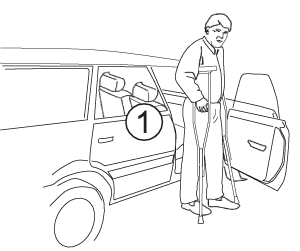

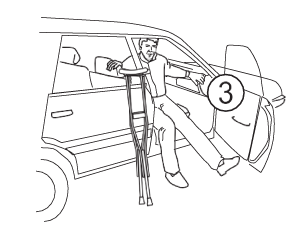
Getting safely into a car
Credit: Bone & Joint Health Strategic Clinical Network, Alberta Health Services
